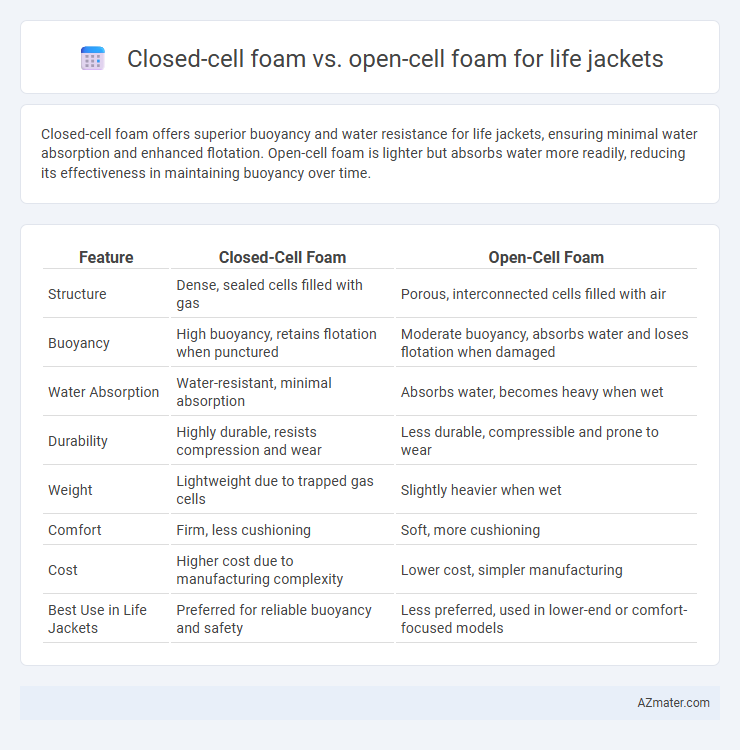Closed-cell foam offers superior buoyancy and water resistance for life jackets, ensuring minimal water absorption and enhanced flotation. Open-cell foam is lighter but absorbs water more readily, reducing its effectiveness in maintaining buoyancy over time.
Table of Comparison
| Feature | Closed-Cell Foam | Open-Cell Foam |
|---|---|---|
| Structure | Dense, sealed cells filled with gas | Porous, interconnected cells filled with air |
| Buoyancy | High buoyancy, retains flotation when punctured | Moderate buoyancy, absorbs water and loses flotation when damaged |
| Water Absorption | Water-resistant, minimal absorption | Absorbs water, becomes heavy when wet |
| Durability | Highly durable, resists compression and wear | Less durable, compressible and prone to wear |
| Weight | Lightweight due to trapped gas cells | Slightly heavier when wet |
| Comfort | Firm, less cushioning | Soft, more cushioning |
| Cost | Higher cost due to manufacturing complexity | Lower cost, simpler manufacturing |
| Best Use in Life Jackets | Preferred for reliable buoyancy and safety | Less preferred, used in lower-end or comfort-focused models |
Introduction to Closed-Cell and Open-Cell Foams
Closed-cell foam in life jackets offers superior buoyancy and water resistance due to its tightly packed cells that prevent water absorption. Open-cell foam, characterized by interconnected cells, provides enhanced flexibility and comfort but absorbs water, reducing buoyancy over time. Selecting the appropriate foam type impacts the life jacket's durability, performance, and wearer safety in aquatic environments.
What Is Closed-Cell Foam?
Closed-cell foam is a dense, water-resistant material used in life jackets to provide buoyancy by trapping air within its sealed cells. Its structure prevents water absorption, ensuring consistent flotation and durability even after prolonged exposure to moisture. This makes closed-cell foam a preferred choice for life jackets requiring reliable performance in various aquatic environments.
What Is Open-Cell Foam?
Open-cell foam used in life jackets features interconnected air pockets that allow water to penetrate the material, resulting in a softer, more flexible structure. Its high breathability and cushioning properties make it comfortable for prolonged wear but less buoyant compared to closed-cell foam. Due to its water absorption, open-cell foam life jackets require proper drying to maintain flotation performance and durability.
Buoyancy: Closed-Cell vs Open-Cell Foam
Closed-cell foam offers superior buoyancy for life jackets due to its tightly sealed cells that trap air and resist water absorption, ensuring consistent flotation over time. In contrast, open-cell foam absorbs water within its porous structure, reducing buoyancy and making it less reliable in prolonged use or harsh conditions. Closed-cell foam is preferred for life jackets because its durability and water resistance provide dependable support during emergencies.
Water Absorption and Durability
Closed-cell foam exhibits superior water resistance due to its structure of sealed, air-filled cells that prevent water absorption and maintain buoyancy over time. Open-cell foam, with interconnected pores, absorbs water easily, which reduces its buoyancy and accelerates degradation when exposed to moisture. Durability-wise, closed-cell foam resists compression and water damage, making it ideal for long-lasting life jackets in harsh aquatic environments.
Weight and Comfort Comparison
Closed-cell foam used in life jackets is denser and heavier, providing superior buoyancy and durability, making it ideal for prolonged water activities. Open-cell foam is lighter and more flexible, offering enhanced comfort and breathability but tends to absorb water, which can increase weight during use. Choosing between the two depends on balancing the need for lightweight comfort versus high buoyancy and resilience in various water conditions.
Insulation and Temperature Regulation
Closed-cell foam in life jackets offers superior insulation due to its dense, non-porous structure that effectively traps air and resists water absorption, enhancing buoyancy and thermal protection. Open-cell foam, with its porous composition, allows water to enter, reducing insulation efficiency but providing increased flexibility and comfort. Temperature regulation in closed-cell foam life jackets is more consistent, maintaining warmth in cold water, whereas open-cell foam can lead to quicker heat loss due to water infiltration.
Cost Comparison: Closed-Cell vs Open-Cell
Closed-cell foam used in life jackets generally costs more upfront due to its higher durability, water resistance, and buoyancy, which ensures longer-lasting flotation performance. Open-cell foam is less expensive initially but can absorb water over time, reducing effectiveness and potentially increasing replacement frequency, which may lead to higher long-term costs. When comparing overall expenses, closed-cell foam offers better value through enhanced safety and durability despite the higher initial investment.
Applications in Life Jacket Design
Closed-cell foam provides superior buoyancy and water resistance, making it ideal for life jackets requiring reliable flotation and long-term durability in marine environments. Open-cell foam offers greater flexibility and comfort, often used in life jackets designed for recreational activities where breathability and lightweight properties are prioritized. Manufacturers select closed-cell foam for professional and safety-certified life jackets, while open-cell foam suits casual water sports gear due to its cushioning and flexibility.
Which Foam Is Best for Life Jackets?
Closed-cell foam is the best choice for life jackets due to its superior buoyancy, water resistance, and durability compared to open-cell foam. Its dense, non-absorbent structure prevents water absorption, maintaining flotation and ensuring safety over extended use. Open-cell foam, while softer and more flexible, absorbs water and loses buoyancy, making it less reliable for life-saving applications.

Infographic: Closed-cell foam vs Open-cell foam for Life jacket
 azmater.com
azmater.com